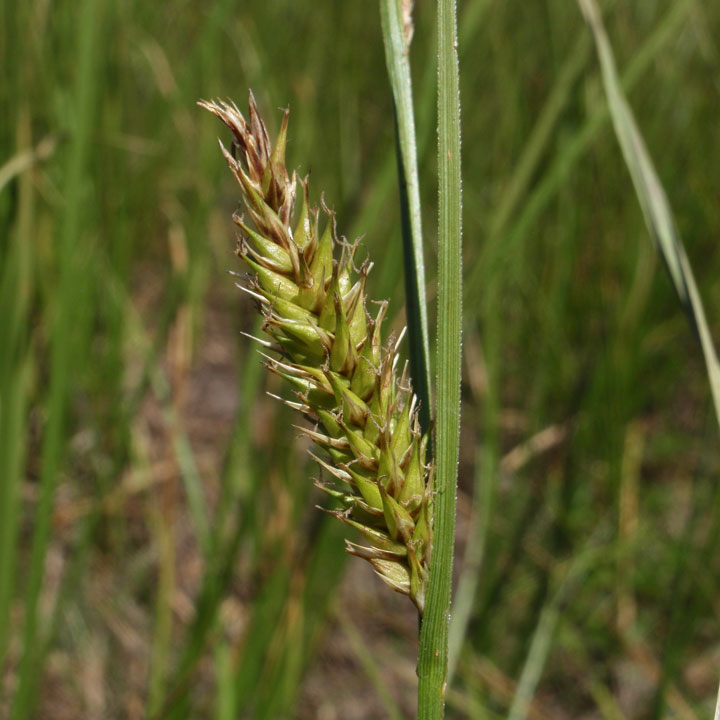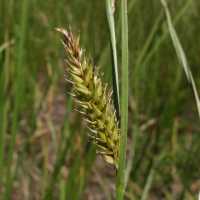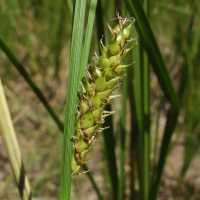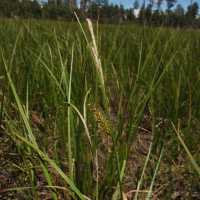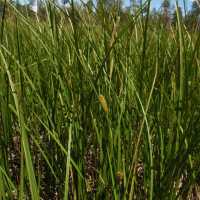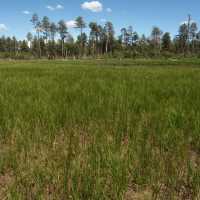Plants cespitose; rhizomes short. Culms trigonous in cross section, 15-105 cm, scabrous-angled distally. Leaves: basal sheaths reddish brown to reddish purple, thickened, not spongy; ligules longer than wide; blades mid to dark green, V- to W-shaped, widest leaves 1.8-6.5 mm wide, smooth. Inflorescences 7.5-45 cm; proximal bract 10-50 cm, exceeding but not more than 2.5 times longer than inflorescence; proximal 1-3 spikes pistillate, erect or the proximal ascending, ca. 20-150-flowered, cylindric; terminal 1-3 spikes staminate, well elevated beyond summit of separate pistillate spikes. Pistillate scales lanceolate to narrowly ovate, 2.4-5.8 × 1.2-1.7 mm, shorter than perigynia, margins entire, apex acute to acuminate, awnless. Perigynia ascending, often green or straw colored, 7-12-veined, veins running into beak, ovate, (3.6-) 4-7.5(-8.2) × 1.7-3.5(-4.5) mm, 2-3.5 times as long as wide, papery, apex contracted; beak distinct, 1.1-2.6 mm, bidentulate, smooth, teeth straight, 0.3-0.9 mm. Stigmas 3. Achenes yellow to pale brown, symmetric, not indented, trigonous, smooth. 2n = 70, 74, 82, 88.
Fruiting May-Aug. Swamps, wet thickets, wet depressions in forests, marshes, sedge meadows, bogs, stream, pond, and lakeshores, often in sites inundated in spring and dry during summer; 0-3300 m; B.C., Man., N.B., Nfld. and Labr., N.S., Ont., Que.; Calif., Conn., Ind., Ky., Maine, Mass., Mich., Minn., Mo., Mont., N.H., N.Y., Ohio, Oreg., Pa., R.I., Utah, Vt., Va., Wash., W.Va., Wis., Wyo., Eurasia.
Carex vesicaria hybridizes with C. saxatilis and, very rarely, with C. hystericina and C. utriculata.
Carex vesicaria as here treated broadly as a variable circumpolar species. K. K. Mackenzie (1931-1935) recognized a small segregate, Carex raeana Boott, but specimens referred here are either depauperate C. vesicaria or hybrids. T. V. Egorova (1999) recognized C. vesicaria as a Eurasian and North American species but also recognized a primarily North American C. monile, occuring locally in Asia as well. The two species were differentiated by characteristics of perigynium length and width, pistillate spike size, and beak and beak teeth size and proportions. The North American material is so variable in perigynium size and shape and inflorescence size that recognizing the two entities seems difficult. Further study of variation in North American material and the relationships of North American and Eurasian material are needed. Indeed, the complex is in need of detailed systematic study on a worldwide scale.
Infrequent in the lake area in swamps, swales, and swampy woods.
Stems 3-10 dm, sharply trigonous, strongly scabrous above, loosely to densely clustered on a system of rather short, stout, branching rhizomes; lvs tending to be septate-nodulose, the blade elongate, flat, 3-8 mm wide; those subtending the pistillate spikes sheathless or nearly so but with elongate blade; spikes several, sessile or inconspicuously short-pedunculate, ±erect, remote, the lower pistillate, the upper staminate, or one of them androgynous; staminate spikes 2-7 cm; pistillate spikes 2-7 נ1-1.5(-2) cm at maturity; pistillate scales somewhat shorter and narrower than the perigynia, thin, acutish to long-acuminate but scarcely awned; perigynia crowded, ascending, ±in 6(-8) vertical rows, 5-8 נ2-3 mm, strongly 10-20- ribbed, lanceolate or lance-ovate in outline, bladdery-inflated below, gradually tapering to the flatter, often poorly defined beak with evident short (0.3-1.2 mm) teeth; achene yellowish, trigonous, 1.7-2.4 mm, loose in the lower part of the perigynium, continuous with the bony, eventually flexuous to strongly contorted style; 2n=74, 82. Wet soil or shallow water in bogs or swamps and the margins of ponds or streams; circumboreal, s. in Amer. to Del., Ky., Ind., Mo., and Calif. Our plants belong to the widespread var. vesicaria.
Gleason, Henry A. & Cronquist, Arthur J. 1991. Manual of vascular plants of northeastern United States and adjacent Canada. lxxv + 910 pp.
©The New York Botanical Garden. All rights reserved. Used by permission.


